

Take Note: How to Curate Learning Digitally. Note taking lies at the heart of curricula around the world.
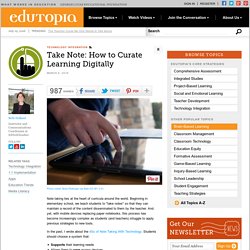
Beginning in elementary school, we teach students to "take notes" so that they can maintain a record of the content disseminated to them by the teacher. And yet, with mobile devices replacing paper notebooks, this process has become increasingly complex as students (and teachers) struggle to apply previous strategies to new tools. In the past, I wrote about the 4Ss of Note Taking With Technology. Students should choose a system that: Supports their learning needs Allows them to save across devices Possesses search capabilities Can be shared While I realize that younger students need scaffolding to learn any system, older students need to think beyond just transcribing information.
Curate Recently, a middle-school teacher mentioned to me that her students could not keep track of everything. Curation implies more than just collecting resources into a folder or notebook. Synthesize Reflect. Why It's Time To Change How Students Cite Their Work. When students write a paper, it goes without saying that they must cite the sources that they use in creating it.

For generations, students have created note cards to document and organize these resources and/or submitted a bibliography page with their finished work. In the modern classroom, student research and creation has taken on a new look. Before, when students created a poster, and then separately handed in a bibliography page to the teacher, justice was done and fair credit was given for the ideas used. However, as widespread sharing of these projects becomes more common, and the internet allows students to reach an audience far beyond the school or classroom, we need to re-evaluate this procedure and address our responsibility to share these sources – not just with the teacher or school, but with all who might consume the project. Without readily available sources to review, the audience cannot truly evaluate the validity of the project. 1. 2. 3. 3.
11 Note-Taking Tips For The Digital Classroom. With less books, paper, and pencils and more laptops, smartphones, and tablets gracing our classrooms these days, it would be logical to say that the nature of note-taking in class has changed, too.
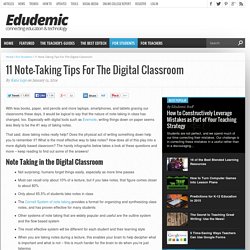
Especially with digital tools such as Evernote, writing things down on paper seems less likely to be the #1 way of taking notes. That said, does taking notes really help? Does the physical act of writing something down help you to remember it? What is the most effective way to take notes? How does all of this play into a more digitally based classroom? In the digital classroom then, the primary shift parallels blended learning: a mix of physical and electronic information that serves as a compromise between “old” and “new” learning. 30 Search Engines Perfect For Student Researchers.
When you need to research something, where do you start?
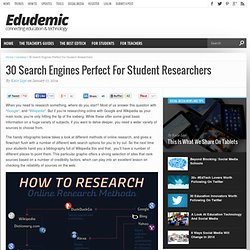
Most of us answer this question with “Google“, and “Wikipedia“. But if you’re researching online with Google and Wikipedia as your main tools, you’re only hitting the tip of the iceberg. Tags: You’re it! Students and educators are embracing all the advantages of digital technology; they are writing blog posts, sharing annotated diagrams and photos, creating video clips and much, much more.
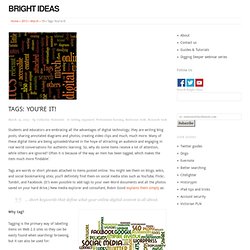
Many of these digital items are being uploaded/shared in the hope of attracting an audience and engaging in real world conversations for authentic learning. So, why do some items receive a lot of attention, while others are ignored? Often it is because of the way an item has been tagged, which makes the item much more ‘findable’. Tags are words or short phrases attached to items posted online. You might see them on blogs, wikis, and social bookmarking sites; you’ll definitely find them on social media sites such as YouTube, Flickr, Tumblr, and Facebook.
. … short keywords that define what your online digital content is all about. Social Media Word Cloud by Rubber Dragon (Flickr CC) Why tag? Organisingclassifyingapplying identity/ownership While tags look like keywords, they work a little differently. Milking Google for What is it Worth. It is snowing again, so what’s new?
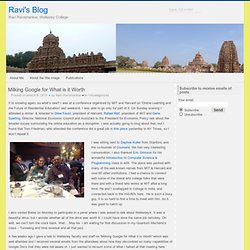
I was at a conference organized by MIT and Harvard on “Online Learning and the Future of Residential Education” last weekend. I was able to go only for part of it. On Sunday evening I attended a dinner & listened to Drew Faust, president of Harvard, Rafael Reif, president of MIT and Gene Sperling, Director, National Economic Council and Assistant to the President for Economic Policy talk about the broader issues surrounding the online education as a disruption. I was actually going to blog about that, but I found that Tom Friedman, who attended the conference did a great job in this piece yesterday in NY Times, so I won’t repeat it. I was sitting next to Daphne Koller from Stanford, and the co-founder of Coursera. I also visited Bates on Monday to participate in a panel where I was asked to talk about WellesleyX.
5 Steps To Make You A Better Researcher. Research involves a lot of information and data which have to be easily and efficiently managed under tight deadlines and time restraints. The following steps will offer you a bit of insight into how you can become a better researcher using some simple web tools like mind maps and bookmarklets. 1.
15 Lesson Plans For Making Students Better Online Researchers. Google is usually one of the first places students turn to when tasked with an assignment.